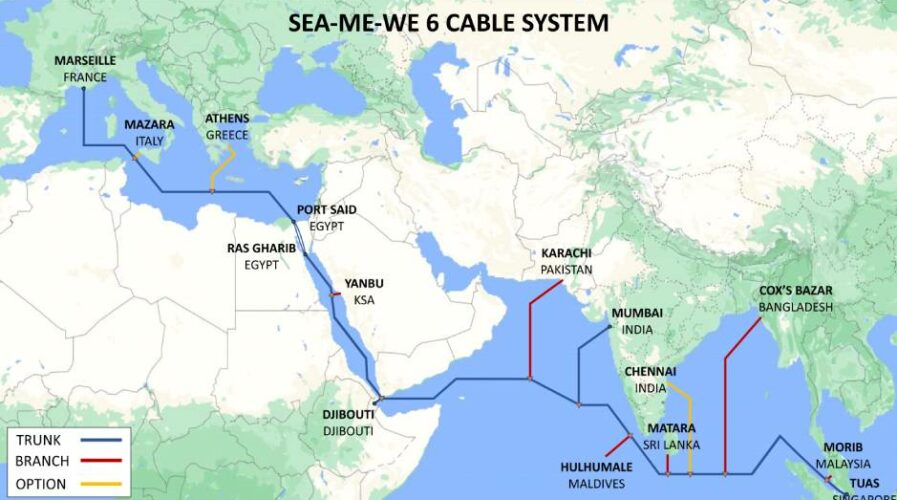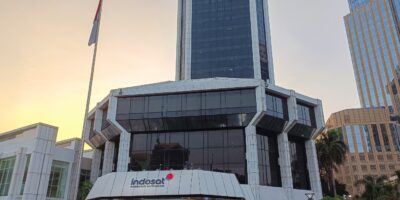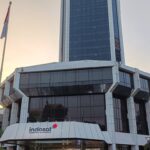
(source – Singtel)
From Singapore to France, undersea cable system to lower Internet latency
Organizations around the world want lower internet latency. Not only will lower latency enable more 5G use cases as well as perfect automation, but it will also be a big boost to hyperscale data centers.
For the internet to have lower latency, the infrastructure needs to be able to provide and support the network. As such, telco companies from several countries have come together to build the foundations to achieve lower latency.
The Southeast Asia-Middle East-Western Europe 6 (SEA-ME-WE 6) consortium has begun construction on a 19,200 km-long submarine cable system connecting multiple countries between Singapore and France. Expected to lower internet latency between Southeast Asia, the Middle East, and Western Europe, the SEA-ME-WE 6 transfers more than 100 terabytes per second, the equivalent of 40,000 high-definition videos each second.
The SEA-ME-WE 6 consortium includes Bangladesh Submarine Cable Company, Bharti Airtel Ltd. (India) Dhiraagu (Maldives), Djibouti Telecom, Mobily (Saudi Arabia), Orange (France), Singtel (Singapore), Sri Lanka Telecom, Telecom Egypt, Telekom Malaysia, Telin (Indonesia), and Trans World Associates (Pakistan).
SEA-ME-WE 6 will have more fiber pairs and more than double the capacity as compared to previous SEA-ME-WE cables.
With the unpredictability of connectivity demands coupled with the dynamic digital transformation that is ushering more and more consumers in Asia through Europe into a digitalized reality, SEA-ME-WE 6 provides an additional layer of diversity and resilience for the high traffic density route between Asia and Europe, strengthening the overall network of each consortium partner, through trans-Egypt’s new geo diversified crossings and landing points.
The added flexibility means service providers in the consortium can rapidly scale capacity, protect traffic from faults, and lower the total cost of network ownership.
Lower latency a boost for data centers
According to Yue Meng Fai, Chairperson of the SEA-ME-WE 6 Management Committee and Senior Director, Consortium Cable Engineering, Singtel, planning and designing for the SEA-ME-WE 6 cable begin more than two years ago, having anticipated the rising demand for reliable, high speed and low latency connectivity led by global digitalization.
“With even more people working and living remotely today, this new cable system will help all parties provide faster broadband access to users along this multi-regional data superhighway while supporting surges from changing working and consumption habits from 5G, remote working needs, and video streaming demands, among others. By building more capacity and flexibility today, we are ensuring that we are ready to serve the billions relying on our networks in the future,” commented Yue.
For TM Group Chief Executive Officer Imri Mokhtar, the investment in SEA-ME-WE 6 will allow TM to address capacity requirements to cater to increasing future digital demand across Asia and Europe while continuing to provide reliable, diversified, and uninterrupted global connectivity solutions to customers. He added that it will also allow TM to support the deployment of hyperscalers’ data centers as well as the future requirements of 5G network in the country.“The SEA-ME-WE 6 submarine cable will land at TM’s new cable landing station in Morib, the latest addition to TM’s existing four (4) international cable landing stations in the country. Its strategic proximity to Klang Valley, which is close to most hyperscalers’ data centers, positions it as a key cable landing site for Malaysia,” explained Mokhtar.
Meanwhile, India’s Bharti Airtel has acquired one fiber pair on the main SEA-ME-WE-6 system and will co-build four fiber pairs between Singapore Chennai Mumbai as part of the cable system. Airtel will land the SEA-ME-WE-6 cable system in India at new landing stations in Mumbai and Chennai.
SEA-ME-WE-6 is expected to be integrated with Nxtra by Airtel’s large data centers in Mumbai and Chennai to enable global hyperscalers and businesses to access integrated solutions and strengthen India’s position as an emerging data center hub in the region.
Ajay Chitkara, Director and CEO, Airtel Business said, “Undersea cable systems along with data centers are vital infrastructure for supporting 5G and the digital economy. Airtel has been ahead of the curve on this front and already operates the largest undersea cable network out of India in addition to the biggest network of data centers. Our investment in SEA-ME-WE-6 is another step in our journey to future-proof our network and build large integrated capacities to enable India’s digital ecosystem.”
The system is expected to be completed by the first quarter of 2025.
READ MORE
- Strategies for Democratizing GenAI
- The criticality of endpoint management in cybersecurity and operations
- Ethical AI: The renewed importance of safeguarding data and customer privacy in Generative AI applications
- How Japan balances AI-driven opportunities with cybersecurity needs
- Deploying SASE: Benchmarking your approach


